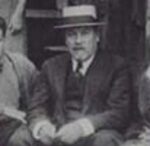
Paul Cornoyer
American, 1864-1923
Old Chelsea with Children Playing, 1890s
oil on canvas
21 1/4 x 26 in.
SBMA, Gift of Dr. Ronald Lawrence
1976.48.1

Paul Cornoyer - undated photo
RESEARCH PAPER
This American Impressionist painting shows children playing in a park next to a Chelsea New York neighborhood in the late afternoon, likely just before they have to go home for dinner. The apartments in the background are dark and moody with the sun setting behind them. There is some light showing on the children’s head and shoulders. There is also a man reading the paper on a park bench nearby. Maybe he is a family member watching them or maybe he is a stranger. This ambiguity lends a somber, reflective tone to the scene. The children aren’t really playing together and the neighborhood seems quiet and still. It creates an atmosphere somewhere between permanent and transient ideals. The fleeting nature of children playing in the park against the permanence of the neighboring apartments creates just enough tension to hold the viewer’s attention.
This tension is reinforced by the diagonal lines of the fencing on either side of the park which leads our eye up to the buildings and the bright sky above. It is Cornoyer’s use of filtered light coming from the late afternoon sky that gives this painting the drama that he creates in the foreground with the children playing and the man reading nearby. That all the characters seem aloof and separated from each other adds to the mystery of this scene.
In this way he creates an ‘Impression’ of this moment in a typical neighborhood in New York that defines what was a popular theme at the turn of the 20th Century, Social Realism. Also, the trees and architectural forms silhouetted against the fading daylight are an enduring Tonalist element in Cornoyer's style, and this effect, along with the expressive brushwork in the sky, gives the painting much of its power.
Old Chelsea with Children Playing’s style doesn’t give up all of its secrets easily. The dark moody nature of the Social Realist style requires the viewer to take a closer look at the details of the scene in order to participate in the activity of the children and the neighborhood. Looking closer, there is a public house mixed in with the apartments which adds to the realism of the scene. In this way “Old Chelsea with Children Playing” associates itself with other Social Realist paintings of city life in New York City in the late 1890s by presenting this moment in time in a non-idealized way.
Paul Cornoyer was born in St. Louis, Missouri in 1864 to Charles and Marie Cornoyer, both of French descent. At the age of 17, Cornoyer entered the St. Louis School of Art, whose director, Halsey C. Ives, acted as a mentor for the promising young artist. By 1889, Cornoyer had accumulated sufficient funds to travel to Paris where he entered the Académie Julian and studied with Jules Lefebvre, Louis Blanc and Benjamin Constant.
Cornoyer returned to his native city in 1894 and subsequently won the gold medal of the St. Louis Association of Painters and Sculptors. In spite of these achievements, Cornoyer was having trouble making a living as an artist in St. Louis.
He had sent a painting to the Pennsylvania Academy of the Fine Arts in Philadelphia to be exhibited. It was admired and purchased by the painter William Merritt Chase who in a later correspondence with Cornoyer, urged him to move to New York City. Cornoyer followed his advice, arriving in New York in 1899, and the move opened up a new world for the artist.
Cornoyer’s association with Chase led him to the studios of such artists as Thomas Dewing, J. Alden Weir, John Henry Twachtman and Childe Hassam, all great ‘mood’ painters who carried the banner for American Impressionism. In 1902, Cornoyer became a member of the prestigious Salmagundi Club.
Cornoyer’s use of gestural brushwork to convey the details of his painting aligns him with other American Impressionist painters in New York. His main difference from his contemporaries is that his paintings don’t show the crowded city life of his contemporaries. He employs a quiet reflective nature which brings the viewer into an intimate relationship with the children and the neighborhood he is showing us. In many of his later paintings he employed an ‘Impression’ of the blurred nature of the city right after a rain to achieve his view of the city as a collection of intimate neighborhoods that have a moody reflective nature.
He continued painting street scenes in New York until 1918 when he moved to Glouster, MA.
Prepared for the Santa Barbara Museum of Art Docent Council by Greg Farrington, Spring 2023
Bibliography
Cornoyer, Paul. Paul Cornoyer, American Impressionist: November 17, 1973 to January 2, 1974, Lakeview Center for the Arts and Sciences, Peoria, Illinois. Peoria, IL: The Center, 1973.
Weinberg, Helene Barbara. American Impressionism and Realism – The Painting of Modern Life, 1895-1915. New York: The Metropolitan Museum of Art, 1994, 179-181.
SBMA CURATORIAL LABELS
St. Louis-born, Cornoyer traveled to Paris, where he studied at the Académie Julian with Jules Lefebvre and Benjamin Constant. When he returned to his hometown, having become adept at an Impressionist technique, he grew discouraged at the lack of interest in his art. He moved to New York in the 1890s where he found a more sympathetic clientele, specifically for street scenes such as this one. Like Childe Hassam and Colin Campbell Cooper, his fellow American Impressionists, Cornoyer provided intimate portraits of well-known Manhattan neighborhoods. His most celebrated paintings are rendered with a careful eye for the atmospheric effects wrought by season, time of day, and weather, as in this idyllic park scene.
- Preston Morton Reinstallation, 2022
